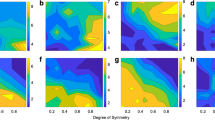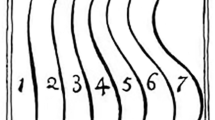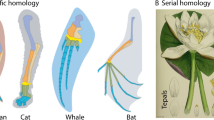Abstract
HUMANS and certain other species find symmetrical patterns more attractive than asymmetrical ones. These preferences may appear in response to biological signals1–3, or in situations where there is no obvious signalling context, such as exploratory behaviour4,5 and human aesthetic response to pattern6–8. It has been proposed9,10 that preferences for symmetry have evolved in animals because the degree of symmetry in signals indicates the signaller's quality. By contrast, we show here that symmetry preferences may arise as a by-product of the need to recognize objects irrespective of their position and orientation in the visual field. The existence of sensory biases for symmetry may have been exploited independently by natural selection acting on biological signals and by human artistic innovation. This may account for the observed convergence on symmetrical forms in nature and decorative art11.
This is a preview of subscription content, access via your institution
Access options
Subscribe to this journal
Receive 51 print issues and online access
$199.00 per year
only $3.90 per issue
Buy this article
- Purchase on Springer Link
- Instant access to full article PDF
Prices may be subject to local taxes which are calculated during checkout
Similar content being viewed by others
References
Møller, A. P. Nature 357, 238–240 (1992).
Swaddle, J. P. & Cuthill, I. C. Nature 367, 165–166 (1994).
Radesäter, T. & Halldórsdóttir, H. Anim. Behav. 45, 626–628 (1993).
Rensch, B. Z. Tierpsychol. 14, 71–99 (1957).
Rensch, B. Z. Tierpsychol. 15, 447–461 (1958).
Berlyne, D. E. Aesthetics and Psychobiology (Appleton, New York, 1971).
Hubbell, M. B. Am. J. Psychol. 53, 46–69 (1940).
Musinger, H. & Kessen, W. Psychol. Monogr. 9, 1–24 (1964).
Watson, P. J. & Thornhill, R. Trends Ecol. Evol. 9, 21–25 (1994).
Brookes, M. & Pomiankowski, A. Trends Ecol. Evol. 9, 201–202 (1994).
Gombrich, E. H. The Sense of Order 2nd edn (Phaidon, London, 1984).
Cronly-Dillon, J. R. & Gregory, R. L. (eds) Evolution of the Eye and Visual System (Macmillan, Basingstoke, 1991).
Tinbergen, N. The Study of Instinct (Oxford Univ. Press, London, 1951).
Mackintosh, N. J. Psychology of Animal Learning (Academic, London, 1974).
Doll, T. J. & Thomas, D. R. J. exp. Psychol. 75, 508–512 (1967).
Staddon, N. E. R. Am. Nat. 109, 541–545 (1975).
Leimar, O., Enquist, M. & Sillén-Tullberg, B. Am. Nat. 128, 469–490 (1986).
Ryan, M. J. Oxford Surv. evol. Biol. 7, 156–195 (1991).
Enquist, M. & Arak, A. Nature 361, 446–448 (1993).
Arak, A. & Enquist, M. Phil. Trans. R. Soc. B340, 207–213 (1993).
Stewart, I. & Golubitsky, M. Fearful Symmetry: Is God A Geometer? (Penguin, London, 1993).
Derefeldt, G. in The Perception of Colour (ed. Gouras, P.) 218–261 (Macmillan, Basingstoke, 1991).
Darwin, C. The Expression of the Emotions in Man and Animals (Murray, London, 1872).
Turing, A. M. Phil. Trans. R. Soc. B237, 37–72 (1952).
Wallace, A. R. Darwinism, an Exposition of the Theory of Natural Selection (Macmillan, London, 1889).
Author information
Authors and Affiliations
Rights and permissions
About this article
Cite this article
Enquist, M., Arak, A. Symmetry, beauty and evolution. Nature 372, 169–172 (1994). https://doi.org/10.1038/372169a0
Received:
Accepted:
Issue Date:
DOI: https://doi.org/10.1038/372169a0
This article is cited by
-
The shape of you: do individuals associate particular geometric shapes with identity?
Current Psychology (2023)
-
Interaction of surface pattern and contour shape in the tilt after effects evoked by symmetry
Scientific Reports (2021)
-
Symmetry and its transition in phyllotaxis
Journal of Plant Research (2021)
-
The Ideal Lips: Lessons Learnt from the Literature
Aesthetic Plastic Surgery (2021)
-
A unified description of translational symmetry breaking in holography
Journal of High Energy Physics (2019)
Comments
By submitting a comment you agree to abide by our Terms and Community Guidelines. If you find something abusive or that does not comply with our terms or guidelines please flag it as inappropriate.



